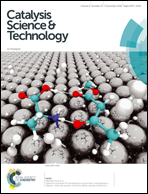Multifunctional 3D K2Ti6O13 nanobelt-built architectures towards wastewater remediation: selective adsorption, photodegradation, mechanism insight and photoelectrochemical investigation†
Abstract
Unique 3D cocoon-like architectures comprising numerous 1D single-crystalline hexatitanate nanobelts with abundant interconnected and open porous structures were successfully grown from chloride flux. In particular, the K2Ti6O13 nanobelt-built architectures (NAs) showed superior selective adsorption of cationic dyes (MB and RhB) and the adsorption capacity of MB was much higher than that of RhB, which was highly related to their porous structures, surface charges and the intrinsic characteristics of dye molecules. The residual contaminants after initial selective adsorption were removed efficiently by the subsequent photodegradation, mainly attributed to the 3D porous NAs with a large surface area quickening the diffusion and mass transport of dyes and reactive species, enhancing the light-harvesting ability and promoting the spatial separation of photogenerated electron–hole pairs. Accordingly, possible mechanisms responsible for crystal growth, construction of 3D NAs, selective adsorption and photodegradation were proposed and fully discussed. More importantly, the K2Ti6O13 photoelectrode exhibited higher photoelectrochemical responses for water splitting than the Na2Ti6O13 electrode, supported by the open-circuit potential measurements, current–potential curves, transient photocurrent responses and EIS analysis, which was consistent with their photocatalytic activities and further highlighted the distinct advantages of 3D porous NAs. Furthermore, the regenerated 3D K2Ti6O13 NAs by photodegradation also showed good recyclability and stability. Overall, our work provided valuable insights into nanoarchitectured design of novel hierarchically porous nanomaterials with multifunctional roles for environmental remediation and solar energy conversion.



 Please wait while we load your content...
Please wait while we load your content...